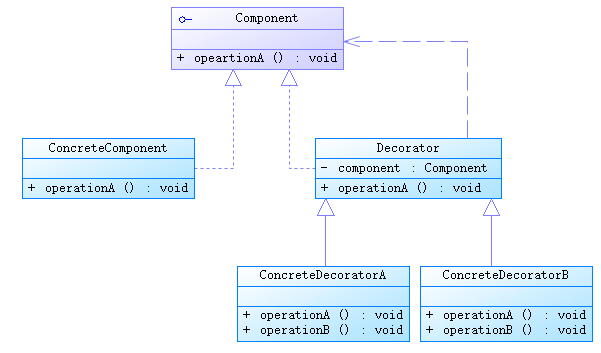设计模式——装饰器模式
2020-03-16 16:01:34来源:博客园 阅读 ()

设计模式——装饰器模式
装饰器模式(Decorator Pattern)允许向一个现有的对象添加新的功能,同时又不改变其结构。这种类型的设计模式属于结构型模式,它是作为现有的类的一个包装。
装饰器模式结构图

- Component(抽象构件):它是装饰类和具体构件的公共父类(一般是接口或者抽象类);
- ConcreteComponent(具体构件):具它是抽象构件对象的子类,用来定义具体的构件对象(Component的子类或者具体实现);
- Decorator(抽象装饰类):进继承抽象构件,用于给具体的构件添加一些新的职责(一般是一个继承了Component的接口);
- ConcreteDecoraror(具体装饰类):实现了抽象装饰类,它负责向构件添加新的职责;
代码演示
业务场景:现我们现在模拟这样一个场景,我们点了一杯奶茶,然后给奶茶中加了冰块,加了珍珠,最后我们还想再给加点红豆,这里加红豆就使用了装饰者。
我们先来创建一个奶茶的抽象类,这个就是上面的Component角色
public interface MilkyTea {
public void recipe();
}我们再来创建要给奶茶的具体子类,相当于ConcreteComponent
public class MilkyTeaA implements MilkyTea {
@Override
public void recipe() {
System.out.println("老板来一杯奶茶,加冰块");
}
}接下来创建一个装饰类,相当于Decorator
public class Decorator implements MilkyTea {
private MilkyTea milkyTea;
public void setMilkyTea(MilkyTea milkyTea) {
this.milkyTea = milkyTea;
}
@Override
public void recipe() {
milkyTea.recipe();
}
}创建装饰类的子类,添加珍珠,相当于ConcreteDecorator
public class MilkyTeaADecorator extends Decorator {
@Override
public void recipe() {
super.recipe();
//对现有类进行功能增强
recipeZZ();
}
// 加珍珠
public void recipeZZ() {
System.out.println("老板再加点珍珠吧");
}
}创建装饰者的子类,添加红豆,相当于ConcreteDecorator
public class MilkyTeaBDecorator extends Decorator {
@Override
public void recipe() {
super.recipe();
recipeHD();
}
public void recipeHD() {
System.out.println("老板你再给加点红豆吧");
}
}最后我们测试一下看下结果:
public class Test {
public static void main(String[] args) {
MilkyTeaA milkyTea = new MilkyTeaA();
MilkyTeaADecorator milkyTeaA = new MilkyTeaADecorator();
MilkyTeaBDecorator milkyTeaB = new MilkyTeaBDecorator();
milkyTeaA.setMilkyTea(milkyTea);
milkyTeaB.setMilkyTea(milkyTeaA);
milkyTeaB.recipe();
}
}JDK中的装饰器模式
在JDK中,IO部分的很多类用到了装饰器模式。

InputStream作为抽象构件(Component),其下面大约有如下几种具体基础构件(ConcreteComponent),从不同的数据源产生输入:
ByteArrayInputStream,从字节数组产生输入;FileInputStream,从文件产生输入;StringBufferInputStream,从String对象产生输入;PipedInputStream,从管道产生输入;SequenceInputStream,可将其他流收集合并到一个流内;
FilterInputStream作为装饰器在JDK中是一个普通类,其下面有多个具体装饰器比如BufferedInputStream、DataInputStream等。我们以BufferedInputStream为例,使用它就是避免每次读取时都进行实际的写操作,起着缓冲作用。我们可以在这里稍微深入一下,站在源码的角度来管中窥豹。
FilterInputStream内部封装了基础构件:
protected volatile InputStream in;而BufferedInputStream在调用其read()读取数据时会委托基础构件来进行更底层的操作,而它自己所起的装饰作用就是缓冲,在源码中可以很清楚的看到这一切:
public synchronized int read() throws IOException {
if (pos >= count) {
fill();
if (pos >= count)
return -1;
}
return getBufIfOpen()[pos++] & 0xff;
}
private void fill() throws IOException {
byte[] buffer = getBufIfOpen();
if (markpos < 0)
pos = 0; /* no mark: throw away the buffer */
else if (pos >= buffer.length) /* no room left in buffer */
if (markpos > 0) { /* can throw away early part of the buffer */
int sz = pos - markpos;
System.arraycopy(buffer, markpos, buffer, 0, sz);
pos = sz;
markpos = 0;
} else if (buffer.length >= marklimit) {
markpos = -1; /* buffer got too big, invalidate mark */
pos = 0; /* drop buffer contents */
} else if (buffer.length >= MAX_BUFFER_SIZE) {
throw new OutOfMemoryError("Required array size too large");
} else { /* grow buffer */
int nsz = (pos <= MAX_BUFFER_SIZE - pos) ?
pos * 2 : MAX_BUFFER_SIZE;
if (nsz > marklimit)
nsz = marklimit;
byte nbuf[] = new byte[nsz];
System.arraycopy(buffer, 0, nbuf, 0, pos);
if (!bufUpdater.compareAndSet(this, buffer, nbuf)) {
throw new IOException("Stream closed");
}
buffer = nbuf;
}
count = pos;
// 看这行就行了,委托基础构件来进行更底层的操作
int n = getInIfOpen().read(buffer, pos, buffer.length - pos);
if (n > 0)
count = n + pos;
}
private InputStream getInIfOpen() throws IOException {
InputStream input = in;
if (input == null)
throw new IOException("Stream closed");
return input;
}这部分的代码很多,这里我们没有必要考虑这段代码的具体逻辑,只需要看到在BufferedInputStream的read方法中通过getInIfOpen()获取基础构件从而委托其进行更底层的操作(在这里是读取单个字节)就可以说明本文所要说的一切了。
至于I/O类库中的其他设计诸如OutputStream、Writer、Reader,是一致的,这里就不再赘述了。
简单总结
- 装饰类和被装饰类可以独立发展,而不会相互耦合。换句话说,Component类无需知道Decorator类,Decorator类是从外部来扩展Component类的功能,而Decorator也不用知道具体的构件。
- 装饰器模式是继承关系的一个替代方案。我们看装饰类Decorator,不管装饰多少层,返回的对象还是Component(因为Decorator本身就是继承自Component的),实现的还是is-a的关系。
- 装饰模式可以动态地扩展一个实现类的功能,比如在I/O系统中,我们直接给BufferedInputStream的构造器直接传一个InputStream就可以轻松构件一个带缓冲的输入流,如果需要扩展,我们继续“装饰”即可。
但是也有其自身的缺点:
多层的装饰是比较复杂的。为什么会复杂?你想想看,就像剥洋葱一样,你剥到最后才发现是最里层的装饰出现了问题,可以想象一下工作量。这点从我使用Java I/O的类库就深有感受,我只需要单一结果的流,结果却往往需要创建多个对象,一层套一层,对于初学者来说容易让人迷惑。
理论的学习还是为了实践。实战中如果需要用到装饰器模式,可以从模仿 Java IO 部分的装饰器模式开始。模仿是创新的开始。
参考
- https://www.runoob.com/design-pattern/decorator-pattern.html
- https://my.oschina.net/u/3178270/blog/2906791
- https://www.cnblogs.com/volcano-liu/p/10897897.html
原文链接:https://www.cnblogs.com/54chensongxia/p/12467971.html
如有疑问请与原作者联系
标签:
版权申明:本站文章部分自网络,如有侵权,请联系:west999com@outlook.com
特别注意:本站所有转载文章言论不代表本站观点,本站所提供的摄影照片,插画,设计作品,如需使用,请与原作者联系,版权归原作者所有
上一篇: 设计模式——适配器模式
- 设计模式-委派/策略模式 2020-06-09
- 深入理解:设计模式中的七大设计原则 2020-06-07
- 设计模式---类之间的关系知多少 2020-06-07
- 你与面试官所了解的单例模式并不一样! 2020-06-06
- 高手眼中的观察者模式有什么不一样 2020-06-05
IDC资讯: 主机资讯 注册资讯 托管资讯 vps资讯 网站建设
网站运营: 建站经验 策划盈利 搜索优化 网站推广 免费资源
网络编程: Asp.Net编程 Asp编程 Php编程 Xml编程 Access Mssql Mysql 其它
服务器技术: Web服务器 Ftp服务器 Mail服务器 Dns服务器 安全防护
软件技巧: 其它软件 Word Excel Powerpoint Ghost Vista QQ空间 QQ FlashGet 迅雷
网页制作: FrontPages Dreamweaver Javascript css photoshop fireworks Flash
